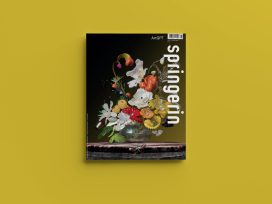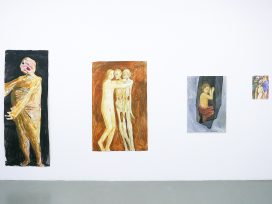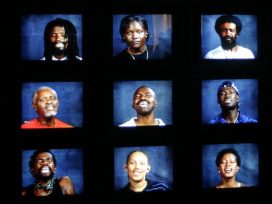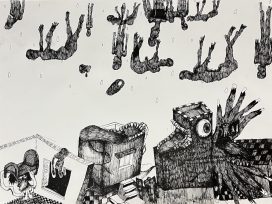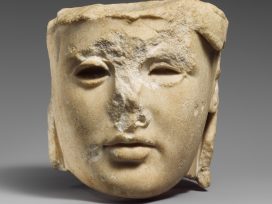John Douglas Millar: In The Return of the Real you wrote that after the defeat of the student movements and the early ravages of neoliberalism the Left took shelter within academia and critical theory became the continuation of the avant-garde by other means. Do the institutions of academia still offer sanctuary? What state are the humanities in?
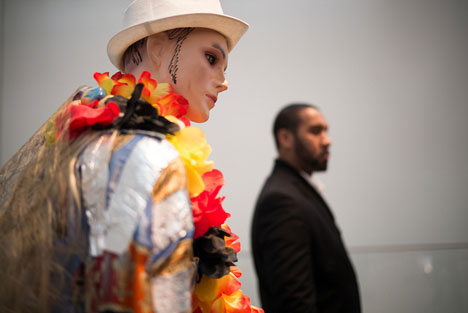
A scene from MOMA’s retrospective of the works of Isa Genzken. Photo: Susan Sermoneta. Source:Flickr
Hal Foster: Well the line that comes to mind first is an old statement by Edward Said from The Anti-Aesthetic where he said, “the humanities now represent human marginality or the marginality of the human”. That was over 30 years ago. In my own case it’s complicated in the sense that modernism and the question of postmodernism could and were discussed in the remnants of the public sphere. Certainly in the States there once was such a thing as an independent intellectual and public sphere. That’s really how October began and that’s how I began too; I worked as a writer and editor for art magazines in that context. However, the art market came to dominate in the 1980s and with the triumph of neoliberalism came the deregulation of the art world and of art institutions in general. So, yes, we went to the academy for sanctuary only to discover that work is a commodity there too. Also, ironically that was the moment in the 1980s and into the early 1990s when critical theory had a special cache and itself became a prized commodity. Well that quickly ended when it turned out universities were not so keen to have this critical virus in their midst. The situation with the humanities now is complicated. Like you say, I work at an elite institution, on the other hand because Princeton is wealthy it has abundant scholarships so that if a young person is admitted to Princeton he or she does not have to pay, so it’s actually quite economically diverse, if not sufficiently ethnically diverse, and so those kids are not quite so driven to become investment bankers. Ironically then, it’s at the state universities that we see the crisis in the humanities where people are asked to develop as human capital, to develop their portfolio of skills to make them good grist for the neoliberal machine.
JDM: “Employability” has become the buzzword here.
HF: Employability, yes. However my feeling is there will always be discontent, there will always be a group of young people who want to be artists, who want to be critics and they’ll find a way. I dedicate my new book to all those alternative spaces, venues and magazines that have cropped up in New York in the last decade or two. I mean it still happens even though it’s extremely expensive to be in New York et cetera, et cetera.
JDM: It’s interesting that you dedicate this book to those art spaces and journals. At one point in the book you say that, “we might reassure ourselves”, when faced with some of the art you are discussing, by relating it to some historical precursors. I wonder though how much the modernist canon that you rely on is relevant to the kind of artists who operate through those same grassroots venues and journals. It seems to me that that particular art history and canon is no longer the context within which a lot of younger artists see their work operating, or not in any kind of privileged way.
HF: I don’t discuss the split between contemporary practice and postwar practice very much in this book. Certainly modernist art is quite distant, but then again I think when ambitious artists develop they do have connections to the past that they might not recognize and that it may be incumbent upon others to extract. So, for example, I was surprised when I wrote about the abject that there would be connections to Bataille, and that when I wrote about the mimetic that there would be a different Dada that would emerge. I don’t think that that is an imposition on my part. I think ambitious practice always reconfigures history. So I do understand that there is this disconnect but new lines also open up. Certainly we’ve lived through a long epoch of art in the context of cultural studies and artists are a lot more involved in the social and the political in a synchronic way and so artists think about work as just so many projects. That tends to devalue the diachronic and the history of medium. But the serious ones, I think, come around to that question too. To sustain a practice you have to develop a language and that language demands an engagement with the past.
JDM: Sure, but perhaps the languages that artists are seeking in the past are not necessarily those of the modernist canon.
HF: Well it depends what you call the modernist canon. At the end of the book I write that there is a new conventionality around postmodernist terms like “indeterminacy” and “the performative”, and that there are cadences and conventions that are relevant at different times and that need to be broken up at different times.
JDM: In the book you write that you don’t want to get involved in debates around the question of the contemporary on the critical or philosophical level that say Boris Groys or Peter Osborne or Terry Smith have, but I wonder if I can draw some thoughts out of you here about it?
HF: I’m not so interested in it as a field personally, in the sense of art history. It’s somewhat oxymoronic the concept of contemporary art history. That discourse seems to function on a very syncretic, very global level where you survey various practices and in a sense mirror the art elite by flying to this biannual and that art fair. I’m not interested. My concerns are fairly parochial in the sense that I remain focused on North American and western European art. But in terms of philosophy, yes, that’s different. You mentioned Peter Osborne and Boris Groys, well, you know, just to be honest I think they overestimate the importance of conceptual art. Peter particularly sees it not just as the dominant paradigm, but as the only paradigm. I don’t think that’s the case. I view conceptual art, as an art historian, as a formation that is not particularly coherent anyway. Peter feels conceptual art reset the terms absolutely. His interest in art and time, well that’s his interest. I am interested in it but it’s not my project. In fact he is somewhere between indifferent to hostile to work like mine. There’s a passing of ships at night.
JDM: Talking of parochialism, I wonder if we might approach a more general question about the state of the Left. Recently there has been debate about the need for a new universalism, but a universalism that doesn’t sublate difference, if that’s not oxymoronic. Where do you stand on such questions? At certain points in the book I felt like the polemic wanted to draw away, or became unmoored from the interrogation of the art works.
HF: That’s complicated. I’m obviously a child of the 1960s, which is to say that I was affected by that period, but I wasn’t formed until the 1970s and in many ways, as we discussed before, critical theory was the Left continued by other means after the defeat of 1968, in a sense; it really was the avant-garde continued by other means. Now, I think there was a theoreticist relation to politics that I inherited, with so many other people, from the poststructuralists, and I think that that is a real debility in my own formation. On the other hand, I emerged as a critic within the discussion of postmodernism, a particular version of postmodernism situated in relation to the second wave of feminism, in relation to not just questions of representation but of the politics of identity and the early reaction to neoliberalism. That was really my horizon in New York as a young critic and editor in the late 1970s and early 1980s. So there politics was quite close, and quite close to artistic practice. There was a very intense triangulation of art, theory and politics. So there was the theoreticist problem but there were also quite terroristic political positions. As the AIDS epidemic developed often you were faced with an ultimatum, “theory OR activism”, and that really wasn’t very productive. So I think that that connection to politics was always there but it came into focus in the shift away from postmodernism, when the body returned to art, but returned damaged as a figure and as a trope of the damaged body politic, as the social contract was trashed and so on. There too there was a politics that was quite direct, a politics of trauma. In the book I talk about the archivist impulse that also has a connection to a politics in its refusal of a society that demands a constant immersion in the present. That might be a politics in a very minor key, but there is a political dimension. The primary idea of the book, I suppose, is the idea of mimetic exacerbation; the idea of an avant-garde that takes a bad thing and makes it worse, that works within capitalism’s junk space. I think there is a politics there, it might be a politics of despair, it might be nihilistic.
JDM: Yes, you describe its power as an “energy of disaster”.
HF: Yes. Well that’s where a certain version of modernist history comes back. This book is, in part, about the legacy of Dada. Not the Dada of Duchamp, the usefulness of which I think has run its course, but the Dada of Hugo Ball. Hugo Ball once described the Dadaist as a person who takes on the dissonances of the age to the point of self-disintegration. Now that’s obviously a very risky strategy, but it’s one that lots of artists who interest me have taken up, like Isa Genken and Thomas Hirschhorn, to an extent. But that’s not a universalist position, rather that seems to speak to the return of constructs of human rights and human values which as a young person I wouldn’t have countenanced at all, I mean I grew up on anti-humanism.
JDM: Yes, as you say, you grew up on anti-humanism but in a recent interview you reaffirmed a commitment to a Kantian Enlightenment project. To what degree is your antihumanism waning?
HF: Well I think that all these terms, all these ideas, all these values are not entirely historically specific, but of course the relation one has to them shifts as the conditions change. So, you know, 32 years ago I edited The Anti-Aesthetic, I now see real possibilities in the aesthetic. I was adamantly anti-formalist because that was the dominant ideology still, but now I see the possibilities of resistance in work that is formal, work that is not simply given over to the informal. So my relation to these things has changed. Kant was the bad guy 30 years ago, but to me now not so much. I have a different relation to judgement, which was once a sin, it represented authority and we were all running away from the author and from authority, but I just don’t think that way any more, I think conditions have changed. So there I am affected by a turn to the universal, it’s a way to see if there’s a version of the human that can be resurrected again. I mean think about the civil rights movement when black men, for the most part, would simply hold a sign and march; a sign that read “I AM A MAN”, that has a certain resonance again.
JDM: With the emergence of Black Lives Matter and the power of the phrase “I CAN’T BREATHE” to organize a collective and yet various sense of injustice?
HF: Yes, absolutely.
JDM: Do you view the Kantian aesthetic in Arendtian terms? I mean does it flavour your thinking on the public sphere?
HF: Yes, I mean obviously the Kantian idea of the aesthetic would have to be revised heavily. It’s not obvious to me how the aesthetic figures in the public sphere in that it’s a subjective experience, which you want to make intersubjective, you want to insist on your experience and find it a matter of consent and consensus.
JDM: Yes but I suppose one can read the judgment as a site of contestation. It’s not a demand for consent with me but with the judgment.
HF: Yes, and to that extent I do agree. I mean I don’t oppose the aesthetic and the critical anymore, I think there is a critical experience that could be part of a public sphere, but we need terms and a discursive engagement around terms.
JDM: To that end can you give a more concrete expression of what you imagine the public sphere to be, even in terms of a possibility? In the book you use the pronoun “we” a great deal. Who is this “we”? To an extent you’ve always been the populist propaganda wing of the October generation and certainly you seem less pessimistic than Benjamin H. D. Buchloh around these questions, if still not exactly optimistic.
HF: Well it’s not hard to be less pessimistic than Buchloh. The public sphere is not connected to the “we” I use in this book, that’s just a little discursive community within which readers might want to participate or not, I mean it’s not simply rhetorical, it is an invitation, or perhaps a plea. The public sphere is heuristic at best; it’s always a hypothetical and contested concept. Just to speak for my sense of what art is, I think it does require coherent debate, cohesive terms that can be shared and challenged. I’m not happy with the condition that seems all too common now whereby there are lots of different conversations but they don’t feel that they have to connect or contest. I still believe that art develops through progressive debate. There can be many debates yes, but then this is also a function of the market, the market is broad enough, you know, that when people have a position they don’t want it challenged, so, you know, “you do your thing, I’ll do mine, let’s not rock the boat”. That’s not helpful either. I don’t though think I can make too many claims for my work in relation to a revived public sphere, but I do think my work hopes to enliven a critical community.
JDM: Swinging back to questions of education, now that the academic institution is no longer a place to find shelter, would you agree that contemporary art has become a holding category for culture generally and, if you do agree, what do you think the positives and negatives of that situation might be?
HF: Well I think that’s right. One thing that struck me with the emergence of relational art was how compensatory it seemed, you know, like: “Oh, social relations elsewhere are diminished, if not destroyed, perhaps we can use art as a site for interaction.” I feel like there’s real pathos there, but also real force, I don’t just mean to decry it. It’s a sad reflection on other spaces and other institutions if that is the case. This is the condition of neoliberalism that most people, even its champions, will admit; it wants to deregulate everything. The ravaged institutions that remain have an enormous amount of work to do. In the United States that’s usually primary schools, where all sorts of social problems are dumped and libraries that become homeless shelters. As the government withdraws from more and more spaces the ones that remain are really burdened. What troubles me in terms of the institutions of art is that the opposite is happening. Rather than act as the last strongholds or even leak-holds of the social, they seem to want to mimic the rest of the market place and become simply another branch of the culture industry. That’s one line of polemic in the book. What art institutions do at their best is provide a site where different temporalities and different ideas of what it means to be a subject in this society can be constellated in works of art, but rather than do that they seem to want to become relevant to the culture that so privileges presence, you know, the live. It’s the entertainment version of self-actualization, of human capital, of how to be fully you at all times. In a way it’s worse than “employability”.
JDM: The question that begs itseIf then is how artists position themselves in the field that you describe? It seems to me that a lot of younger artists view the institution as an opportunity, something to use in order to access funding streams. They use it opportunistically and strategically, they’re not committed to it in the way that say the institutional critique generation were.
HF: I think that’s right. My generation of artists advanced the idea of the criterion of criticality. We were students of institutional critique and developed it. What strikes me about artists of the next generation is that that value was given up. Rather than change the game of the art-world they wanted to win it. If success had been to upset the institution then now success became how to dominate the institution. I could name names but I think that that is one version of the problem. What you say about the next generation, suggesting that it’s more opportunistic, more hit and run, well yes I think that’s right. However, there’s always an appetite for youth so I think that “jump in/jump out” mentality is dangerous. There’s always an appetite for the new but it’s also the case that with the return of performance and with the return of process well that suits the institution. There might be a change now after disasters like the Bjork exhibition at MoMA. I’m very interested in how performance functions in the institution, this idea that we have to be animated, we have to be live, we have to be present: The Artist is Present. But then there are other artists who play with presence, who play with performance and do re-enactments that are quite critical. They use performance in the gallery or in the museum to really call up different moments, political moments, be it Jeremy Deller or Sharon Hayes, there are many I could name. So it’s not to say that everything to do with the performative is now compromised. I think there are ways in which artists have turned that appetite for presence around and taken it somewhere else.
JDM: Two semi-connected questions. Firstly I wonder how you feel about the rise, or perhaps return, of affect theory; and secondly, it seems to me that a lot of younger artists – somewhat less well established or visible than Jeremy Deller perhaps – are really actively withdrawing from the institution as irrevocably tainted and from the supposed authority of the critical into a paradigm of learning and an exploration of radical non-hierarchical pedagogic structures. This clearly has to do with not just the institution of art, but also the institution of education becoming untenable. Now that seems to me to also grow out of an engagement with the struggle for black rights in the US and its long history of radical organization and education and with the history of consciousness raising in various feminist and queer traditions, but also out of an engagement or recognition of minority positions more generally. Also, I wonder how this sits in relation to certain anti-humanist positions. It’s fine to denigrate or reduce the role of the subject but what about for those who have had to struggle for recognition as subjects within the public sphere?
HF: Ok, right, let me try and take those one at a time. Affect first. I’m interested in this discourse. It often strikes me, to the extent that I know it, and to the extent that it comes out of Deleuze, as a renewed version of an avant-garde of radical disruption where the affective is about intensities: physical intensities and psychic intensities, that are somehow ipso facto transgressive and radical. Now that might be a misreading and to be honest I’m not so interested in that neo-neo-avant-garde of the affective. I think it’s limited in its possibilities. I think there’s another use of affect that disturbs me much more though, and that is affect understood quite differently as a kind of emotionality that circulates through mass media and that is not quite our own but that we feel somehow anyway and that interpolates us in some way, like, “why do I care more about this celebrity than that friend?” I think in a funny way affect has become an ideological super-corporate apparatus, the manipulation of emotionality. That is, I think, really important to think about, and some artists have; the way Thomas Hirschhorn looks at the tensions of the fan for example, as Ernst Bloch said, those atavistic feelings that the Right knows how to use. How do we channel the enormous energies of resentment into a political community, how do we channel the enormous passions of a football fan? I think those are really important political and aesthetic questions.
JDM: Yes, I’m thinking about how “feeling” and “experience” have become increasingly valorized or attended to. The rise of the notion of “safe-spaces” where one can express the way the various violences of neoliberalism make one hurt and suffer. It seems to me there are potentials there but also certain tensions and dangers.
HF: Yes, I think that that is of real interest, I don’t understand it as having political value though, I’m not sure what forms of connection it can make.
JDM: It comes back to something we touched on earlier which is the question of how the Left (and here I recognize that the Left is not something given, indeed it is now a contested term perhaps more than ever), how the Left might conceive of building something like hegemony or of a progressive universalism while attending to difference and particular grievance?
HF: Well before affect discourse there was trauma discourse and that, I think, anticipated some of these interests in difficult experience. I see it in terms of black communities in the States where there is a real renewed sense of abuse and suffering that is quite existential. Now, how that particular suffering is made collective, well we’ve seen moments around particular shootings and around the Black Lives Matter movement but to the extent that is based in the traumatic I think it has to be limited. Trauma is the shattering of the subject and it is difficult to know how shattered subjects can form any kind of solidarity. I think, though, that that is something so present that it’s hard to see exactly how it will develop.
With the question of learning, do you mean in terms of the pedagogical turn?
JDM: Perhaps. I was thinking that there is a general withdrawal, as we discussed earlier, from the site of the institution as one where criticality might be generated. I think the institution is generally seen as critically bankrupt and the current political situation so violent and total that artists are withdrawing into slightly clandestine communities and embracing alternative models of pedagogy and they’re not doing it under the name of an art project or whatever, they’re doing it so as to assemble materials for living, or perhaps just surviving, under current conditions. I do think it has its limits and there are occasions when it merely slides into a kind of dull anti-intellectualism, but equally I think it can have potential and, to be a touch melancholic, I’m not sure how much more we can hope for right now.
HF: Well that’s a positive development, as I see it, of an anthropological turn in cultural studies; a movement towards groups and bodies of knowledge that are not normally touched upon by artistic forms or by art institutions. I think that the problem is with something called social practice art. There I think the terms break apart and one becomes the interrogation for the other. If you, as an artist, are seen to be too interested in formal matters you get beat up by the social side and if you’re deeply invested in the social you’re seen as merely social. Maybe there has to be a parting of ways there.
JDM: So we have various philosophies of contemporary art, we have prehistories in books like yours; is it perhaps the case then that what we need is an anthropology of contemporary art? An examination of the networks, the tech, the interests and behaviours at work in “contemporary art”. Or perhaps for someone to do the real Marxist work, the actual number crunching as it were, produce a Morettian approach?
HF: Oh god! Moretti really divides his work. There’s the great reader of literature and the ideology critic in the old sense, and then there’s this statistical view from on high. No, I think that’s true but it’s just not my project, and you know, there I could ask you which “we” you mean when you say “we”? I think, for myself, I can only do what I have the capacity to do. Often when you publish a text or a book people take it to mean that you exclude other possibilities. I’m more ecumenical than that. I just have to work with what I’m given in my little sphere.
